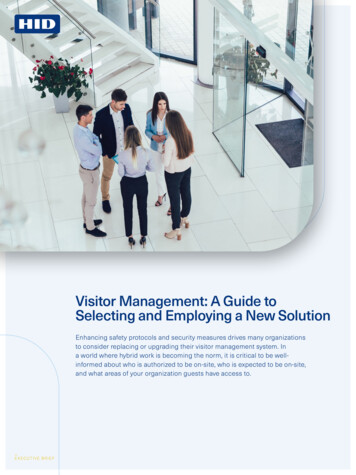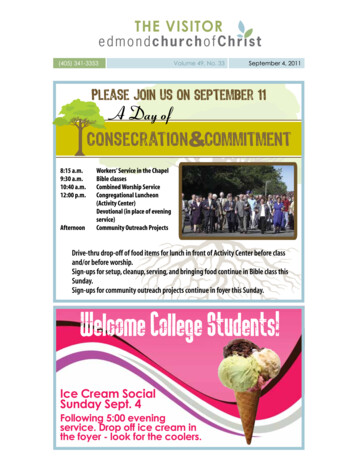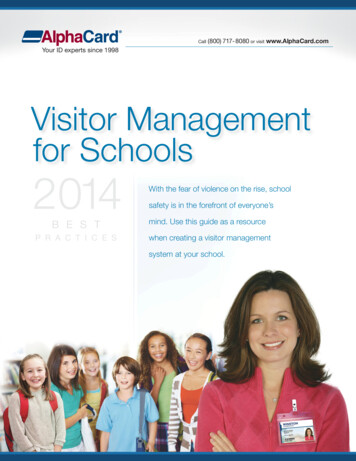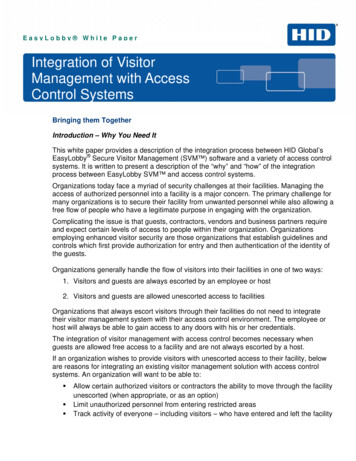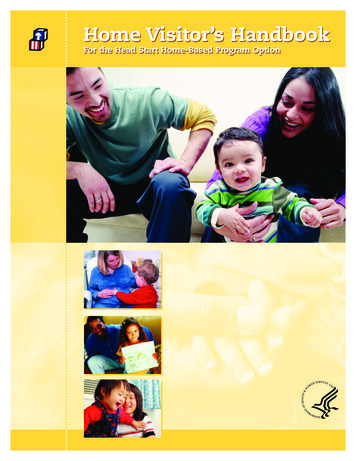
Transcription
Home Visitor’s HandbookFor the Head Start Home-Based Program Option
The Home Visitor’s Handbook for the Head Start Home-Based Program OptionU.S. Department of Health and Human ServicesAdministration for Children and FamiliesAdministration on Children, Youth, and FamiliesHead Start BureauPrepared for the Head Start Bureau, under contract #105-98-2055,by the Early Head Start National Resource Center @ ZERO TO THREE
Home Visitor’s HandbookFor the Head Start Home-Based Program OptionTable of ContentsIntroduction 2Part 1 Essential Elements of the Home-Based Program Option 4Part 2 Frequently Asked Questions 7Part 3 Partnerships With Families 12Part 4 Home Visits 17Part 5 Socialization Experiences 23Part 6 Getting the Support You Need 28Part 7 Your Community 32Part 8 Additional Resources 35Appendix A Information Memorandum 39Child Development Services During Home Visits and Socializationsin the Early Head Start Home-Based Program OptionAppendix B Information Memorandum 48Services to Pregnant Women Participating in Early Head Start
The Home Visitor’s HandbookIntroductionIn your role as a home visitor, you provide comprehensive Head Start services to families. TheHead Start Program Performance Standards (45 CFR 1304, 1306, and 1308) identify the range ofservices that you must arrange for or provide to the families you visit, including screening andongoing assessment of child development; medical, dental, and mental health services; childdevelopment and education; and family partnerships that focus on setting goals and identifyingthe responsibilities, timetables, and strategies for achieving those goals.You have the opportunity that most professionals do not have to take a glimpse into the lives ofchildren and families. Your role is unique, and the relationships you build with families are themost powerful tool you have to support young children and make a difference in their lives.Your work is challenging. It is also enormously rewarding. You are not expected to do it all onyour own. We hope this Handbook will help you to discover how you can be your own bestresource and how your supervisor and colleagues, the families with whom you work, and yourcommunity are all vitally important to the success of your program.The Home Visitor’s Handbook for the Head Start Home-Based Program Option was created to help youunderstand and do your job. This Handbook is part of a set of materials for the Head Start homebased program option: (1) The Program Administrator’s Checklist for the Head Start Home-BasedProgram Option; (2) The Home-Based Supervisor’s Manual for the Head Start Home-Based ProgramOption; (3) The Home Visitor’s Handbook for the Head Start Home-Based Program Option; (4) A Parent’sGuide to the Head Start Home-Based Program Option; (5) The Beginning at Home video for the HeadStart Home-Based Program Option; and (6) The Beginning at Home Video Guide for the Head StartHome-Based Program Option.The Program Administrator’s Checklist for the Home-Based Program Option is a tool for programadministrators to consider how community needs and resources may make the home-basedprogram option the best choice for your community. The Checklist presents a number of questions that program leaders should address as they plan home-based services.The Home-Based Supervisor’s Manual for the Home-Based Program Option provides your supervisor with information, materials, and strategies to support you in your work with families. TheSupervisor’s Manual contains background information on the history of home visiting; therequirements outlined in the Head Start Program Performance Standards for home visits and socialization experiences; the process for effective supervision of home visitors; and materials to support supervisors in their own professional development. The Supervisor’s Manual will help youknow what to expect from your supervisor and how the two of you, together, support the families with whom you work.2
IntroductionThe Home Visitor’s Handbook for the HomeBased Program Option provides you withtools to help you do your job. First, we provide the context for home visiting to helpyou understand the big picture—why homevisiting is a successful strategy for delivering services and how to determine whetherhome visiting is the right option for families. The next section of the Handbookexplores the “frequently asked questions”of home visitors and provides you withsome answers to the questions that mightbe on your mind. Next, we discuss the relationship-building process with families aswell as what you actually do on home visitsand during socialization experiences.Finally, we address how you can get thesupport you need to do your job well, howto collaborate with community partners,and where you can find resources for moreinformation.A Parent’s Guide to the Head Start Home-Based Program Option is designed for you to use withthe families in your home-based program. It is written for parents to help them better understand how home visits work, what they can expect from you, the role parents play as the child’sfirst teacher, and how the home is a learning environment. The Parent’s Guide is interactive. Itprovides space for you to personalize the information for each family and for family membersto write their own thoughts about parenting and how they support their child’s development.The Beginning at Home video offers 5 vignettes that demonstrate different aspects of a home visitor’s relationship with a family, and how those relationships are having an impact on the children and families with whom they work. The Beginning at Home Video Guide for the Home-BasedProgram Option offers viewers an opportunity to deepen their understanding of the video content through discussion questions and training exercises.Although each of these resources is designed with a particular audience in mind, they work bestwhen used collaboratively. Home-based supervisors, home visitors, and the families with whomyou work each play an equally important role in meeting the goals of home-based Head Startservices.3
Home Visitor’s HandbookHead Start Home-Based Program OptionPart 1 Essential Elements of theHome-Based Program OptionHome visiting is a method of service delivery. It is a way to offer support, guidance, information,and child development services directly to families in their homes. The Head Start home-basedprogram is one of the options (45 CFR 1306) for delivering comprehensive Head Start services.Home visiting is unique because it offers an opportunity for families to get the support theywant in their own homes. Home visiting allows you to do the following:uuuuUse the home environment to help parents create rich learning opportunities that build oneveryday routines and support their child’s development. The parent’s ability to recreate thechild development experiences after you leave is equally important to what you do duringthe home visit.Provide support to families whose life circumstances might prevent them from participatingin more structured settings, families such as those who suffer severe stressors like maternaldepression or substance abuse. Working in the environment where families are most comfortable often lets you get to know families in a much more intimate way, which sets thestage for close, trusting relationships—the critical element in any program designed to support children and their families.Be flexible and offer support and child development services during nontraditional hours tofamilies who work or go to school.Work with families who live in rural communities and who otherwise would not be able toreceive needed services.Is the Home-Based Program Option the Right One for a Family?The Community Assessment, conducted once every three years (45 CFR 1305), gives essentialinformation about the needs of families and resources available in your community. If any significant changes in the needs or resources available to families have occurred, the CommunityAssessment should be updated and program administrators should reevaluate how your HeadStart program can best meet community needs, including whether the home-based programoption is appropriate for the current circumstances in your community.Before a family is enrolled in the home-based program option, programs need to explorewhether the family’s needs and circumstances are appropriate for this program option. Familyneeds and resources change, and thus, a child may move from one program option to another ifa more appropriate option is available. Many Head Start and Early Head Start programs offer avariety of program options to meet changing family needs.4
Part 1 Essential ElementsIn addition, a child enrolled in a center-based option, a combination-option, or a locallydesigned program option may also receive home visits as an enhancement of those services.Under these circumstances, the home visits are conducted according to the requirements of theprogram option in which the child is enrolled and are based on family needs. The requirementsfor the home-based program option as specified in 45 CFR 1306.33 are only for children who areenrolled in that program option.As you consider enrolling a family in your home-based program, consider the following questions:uuAre the children’s parents or other legal guardian (e.g., foster parent or custodial grandparent)available to participate in the home visits and socialization experiences, as well as committedand able to reinforce the child development goals during the time between home visits?Child care providers and other temporary caregivers cannot substitute for the parent duringhome visits [45 CFR 1306.33(b)]. Parents should know that, during the week when you are notin their home, they are expected to recreate and build on the learning experiences that youcollaboratively plan and conduct on home visits. You should consider how you will involveboth of the parents, the extended family members, or other significant members of thehousehold in your home visits and in the program.Is this family available for the number of home visits and the duration of the home visits thatare required by the Head Start Program Performance Standards?You are responsible for conducting home visits on a weekly basis for 90 minutes duration (45CFR 1306.33), which is the measure of the intensity of the services. Home visits must reachthis level of intensity to achieve the child development outcomes of the Head Start program.Note that the federal regulations in 45 CFR 1306.33that specify the yearly number of home visits andsocialization experiences are based on a 9-monthpreschool Head Start program. Head Start andEarly Head Start programs that offer year-roundservices are expected to adjust those numbers toprovide weekly home visits and two socializationexperiences per month for 12 months a year.Although the goal of weekly home visits andbiweekly socializations is the ideal, it may not be agoal you reach with every family each year. If younotice that a particular family or a significantnumber of families are not available for the intensity of home visits required by the ProgramPerformance Standards, you and your supervisorshould carefully reevaluate whether the home-5
Home Visitor’s HandbookHead Start Home-Based Program Optionbased program is the appropriate program model for those families. In the case where significant numbers of families are not available for home visits in your community, your programadministrators should reevaluate community needs and resources as well as the programoptions that might best meet family needs.uAre there any barriers that might prevent this family from fully participating in the program?Families are complex. A family’s needs, resources, and goals are fluid and can change unexpectedly. Accept that you cannot meet the needs of every family that calls on your program.Sometimes you will not be able to help. No one program and no individual home visitor canrealistically help everyone. Know the limits of your program as well as your own professionaland personal boundaries.For example, some family members may be hesitant or uncomfortable with the idea of astranger coming to their home. Be sensitive to how parents or other extended family members might feel about your presence in the home. Perhaps one parent wants you to be there,but his or her spouse does not. Recognize how this tension will become part of the work youdo with the family and how the particular individuals with whom you work will shape yourrole. (See Part 3 of this Handbook for more information on effective family partnerships.)uIs this family available to participate in biweekly socialization experiences outside of the home?Be aware of the obstacles families might face with this aspect of the home-based programand brainstorm ahead of time how you might help families address any issues that couldprevent them from attending socialization experiences. For example, does the family needtransportation to get to the socializations? Explore whether your program will need to provide child care for siblings who are too old or too young for the socialization experience.Home visiting may be ideal for some families. However, it will not be the right program optionfor every family. The first step in building a quality home-based program is to ensure that youare reaching the families that the home-based option is designed to engage. Learn to recognizewhen the program model is not the right fit for a particular family, and help them to find theresources that will better meet their needs.6
Home Visitor’s HandbookHead Start Home-Based Program OptionPart 2 Frequently Asked QuestionsThe following are examples of commonly asked questions about the home-based programoption. The answers are provided here as a guide; they are not intended to be an interpretationof policy. Whenever you have a specific question about Head Start policy and your Head Startprogram, your agency should seek the guidance of your Federal Program Specialist at theAdministration for Children and Families (ACF) Regional Office.Questions About Home VisitsQ: The Head Start Program Performance Standards and program option regulations require homevisitors to provide comprehensive services. Am I expected to be an expert on everything—nutrition, health, family dynamics, child development, and all the other areas covered in the ProgramPerformance Standards? How do I do it all?A: The Program Performance Standards do require that all the comprehensive Head Start servicesare available to families in the home-based program option. You are responsible for introducing these services and for arranging or providing these services (45 CFR 1306.33). The ProgramPerformance Standards also specify the knowledge, experience, and skills that you need to doyour job well [45 CFR 1304.52(e)]. However, you are not expected to be an expert in all things.You are expected to be familiar with and to help families access resources for all the elements of the Head Start program. This expectation is one reason why your community partnerships and the management systems for tracking services are vitally important in thework that you do. Know your limits and know when you must refer families for help. Seekprofessional development experiences in areas where you need further training or want toimprove your skills. Your supervisor and other colleagues are key resources to help you meetthis challenge. With your supervisor, discuss the expectations for your role, any concerns youhave, and ways he or she can help you provide comprehensive services to families.Q: If a family needs child care, can that family also be enrolled in the home-based program option?A: A family who needs child care is best served by a comprehensive system of coordinated services. Thus, a center-based option, combination option, or a child-care partnership would provide both the child care needs and the comprehensive Head Start services. A child participating in part- or full-time child care may also benefit from home visits because of particularfamily circumstances, needs, or goals. In this case, the child might be enrolled in the centerbased option and receive home visits as an enhancement to those services. Alternatively, thechild might be enrolled in a combination program option and receive both center- and homebased services as specified in 45 CFR 1306.34.7
Home Visitor’s HandbookHead Start Home-Based Program OptionQ: What do I do if a family has a 4-year-old in Head Start and an infant in Early Head Start. Howmany home visits does this family get per week?A: Each family receives one 90-minute home visit per week regardless of the number of childrenenrolled in Head Start or Early Head Start. Home visits with multiple children requirethoughtful and creative planning as well as collaboration between the Head Start and EarlyHead Start program to ensure that you address the child development goals of all the children. This coordination is particularly important when the Head Start and Early Head Startprograms are operated by different agencies.Q: Sometimes parents have so much going on in their lives that I have a hard time getting them tofocus on the children during our home visits. How can I incorporate both the parent’s and thechild’s goals into the home visit?A: Focusing on the children is enormously challenging when parents are dealing with difficultor overwhelming life circumstances. Yet, you are in the home to deliver Head Start serviceswith the overall goal of promoting healthy child development. If you are working with parents who are dealing with challenging situations, it is important that you help the parentsget the support they need so they can meet their child’s needs. Listen attentively, and whenever possible, provide resources. Then, bring the focus back to the child by discussing howthe parent’s situation is having an effect on the child.For example, if a parent is overwhelmed by financial problems, after you have spent sometime addressing those issues, you might inquire whether the baby has enough food and diapers. Ask the parents how they think the baby is reacting to the increased stress in thehousehold. Then link your child development experience to the current situation. In thisexample, you might talk with the parent about how the baby needs consistent routines, especially during times of stress, and help the parents structure their day. You could come upwith activities that are soothing to both the parent and child, for example, more time cuddling in the rocking chair, reading favorite stories, or singing gentle lullabies. In this way, youare supporting parents while simultaneously helping them to support their children.Q: One of the families I work with keeps canceling our home visits, and I know that I am not goingto see them 52 times this year. I will be lucky to see them half that amount. Should they be terminated from the program?A: The intensity (frequency and duration) of the services is a critical factor in your program’sability to achieve the anticipated outcomes for children. As described in Part 1 of thisHandbook, the Program Performance Standards require that you offer each family weekly homevisits and two group socializations per month (45 CFR 1306.33). The actual number of visitsyou accomplish may vary because of illness, vacation, holidays, or other circumstances.However, if a family demonstrates a consistent pattern of cancelled or missed appointments,then you need to question whether the home-based model is the appropriate choice for thatparticular family. In a case such as this one, work with your supervisor to (a) identify andremove the barriers that are preventing the family from fully participating in the program or(b) find another program option that better meets the family’s needs.8
Part 2 Frequently Asked QuestionsQ: What kind of flexibility is permitted with respect to how many families I work with at one time?I am working with 10 families, and I seem never to have enough time to plan, attend socializations, and do my record-keeping tasks, much less anything extra like go to a training that I wantto attend.A: The Program Performance Standards (45 CFR 1306.33) indicate an average of 10 to 12 familiesper home visitor. The maximum number of families you can serve is 12. At any given time,the number of families that you are working with can be lower than the average of 10 to 12families, depending on the needs and circumstances of the particular families with whomyou are working. Families with more complex life circumstances and greater needs will naturally require more of your time. Logistical concerns such as the distance you must travel toreach families should also be considered when deciding how many families you can serve.Talk with your supervisor if you think the quality of the services you provide to families issuffering because of time constraints.Q: How often do I have to complete vision and hearing screenings?A: You must obtain an initial screening for vision and hearing within 45 days of the child’s entryinto the program [45 CFR 1304.20(b)(1)]. Frequently, you can obtain preexisting informationsuch as a recent vision or hearing test that was performed at the child’s last well-child healthvisit. If preexisting information is not available, then you will have to arrange for an ageappropriate screening, which can usually be accomplished during a well-child medical exam.After this initial screening at the time of entry into the program, the frequency of vision andhearing screenings are determined by your state Medicaid program. The schedule of ageappropriate preventive and primary health care must reflect the requirements for a scheduleof well-child care used by the Early and Periodic Screening, Diagnosis, and Treatment (EPSDT)program of your state Medicaid agency. This schedule must also incorporate the latest immunization recommendations issued by the Centers for Disease Control and Prevention and therecommendations of your Health Services Advisory Committee that reflect the specific needsof your community [45 CFR 1304.20(a)(1)(ii)]. Thus, vision and hearing screenings follow your9
Home Visitor’s HandbookHead Start Home-Based Program Optionstate EPSDT schedule and are performed as a part of well-child care health exams. However,as part of your ongoing assessment of children, any time that you or a parent has a concernabout a child’s health or development, you should refer that child for further evaluation toensure the early identification of health or developmental problems.Questions About Stress and SafetyQ: How do I handle the challenges of being a home visitor? I feel like I am taking all the family’sproblems home with me. I am worried about getting burned out.A: If you sense that you are becoming burned out, seek the support of your supervisor. The firststep is to recognize the signs of stress and burnout. Your frustrations, worry, or distressshould not get to a level that interferes with your job or your life outside of work. Try to identify the supports that would help you: informal peer support to talk openly about the challenges of your work; validation from your supervisor about the work you do; in-depth consultation on specific issues; access to mental health professionals; or time off to rest and recuperate from the demands of your job. The more proactive you are in meeting your ownneeds, the better you will be able to meet the needs of children and families.Q: Some of the homes I visit are in rough neighborhoods. I am afraid to go there. I have been wondering if I am just not cut out for this work.A: Talk with your supervisor about your discomfort and try to determine what you find threatening. Carefully examine exactly what it is that is making you feel uncomfortable. In somecases, your concern might be about things you witness—drug deals, fist fights, or vandalism.Perhaps you sense a feeling of vulnerability when you drive long distances on a desertedroad after dark. In other cases, your discomfort might be less obvious and rooted in the unfamiliar. If you are working in diverse communities, it is not unusual to feel some discomfortuntil you become familiar with the community and culture. Examine your own beliefs andattitudes and educate yourself about cultural differences.Ultimately, your safety is your first priority, and it is of equal concern to your program administrators. Identify the things you can do to protect yourself. If your agency does not have aprotocol for dealing with safety issues, your first step might be to approach your supervisorto develop one. For example, perhaps you would feel comfortable if you had a cell phonewith you and a telephone number where your supervisor or other support person was readilyavailable should you need assistance. Or perhaps, in some neighborhoods, home visitorsshould go on home visits in teams, never alone. Your local police department might be ableto provide crime-prevention training or self-defense classes. The police may also provideadditional police protection if they are aware that you are in the community. In addition, youcan enlist the families’ support in protecting your safety. They often can tell you what youneed to know to travel safely in the neighborhood, for example, what streets to avoid, locations of safer places to park, or the safest time of day to visit.10
Part 2 Frequently Asked QuestionsQuestions About Socialization ExperiencesQ: Do we have to provide formula and diapers at socializations?A: You must provide appropriate meals and snacks during socialization activities [45 CFR1304.23(b)(2)]. Formula or baby food is an appropriate meal or snack for an infant. In fact,socializations are an ideal time to address nutrition and healthful eating habits. Socializationexperiences also provide opportunities to model and teach proper health and hygiene practices. You should have appropriate toileting and diapering facilities available, including diapers, wipes, and other necessities, to ensure comfort and reduce the health risks for participating children and adults.Q: Should siblings attend socializations?A: Siblings may or may not attend socializations. Their attendance depends on the age anddevelopmental level of the children for whom the socialization is designed; the goals of thesocialization; logistics such as room capacity, licensing requirements, and staffing patterns;family circumstances such as available child care; and your program’s design for socializations. In the case of a family with multiple children under the age of 5 years, it may be unrealistic to expect parents to attend a different socialization for each child. Thus, you mightdesign socializations for mixed age groups that allow parents to participate with all of theirchildren. In other cases, parents might welcome the opportunity to spend individual timewith their children and you might develop your socialization for a specific age or developmental level and provide on-site child care for older or younger siblings. Be flexible, be creative, and design your socialization experiences to meet the needs of the families with whomyou work.11
Home Visitor’s HandbookHead Start Home-Based Program OptionPart 3 Partnerships with FamiliesOne of the unique strengths of the Head Start program is the array of opportunities for parentinvolvement and decision making. In fact, the partnerships you build with families are the foundation of Head Start success. Successful relationshipswith families are characterized by mutual respect,trust, acceptance, objectivity, flexibility, personalized attention, and cultural awareness.1The process to collaboratively build a partnershipbegins during your first contact with parents. It isimportant to recognize that the relationship-buildingprocess will vary for each family, depending on howwilling and ready parents are to participate in theprocess. Family members bring to this relationshiptheir past experiences with other agencies or serviceproviders, their individual temperament and personality traits, as well as familial and cultural values—all of which influence how they relate to you.I became a single parent two yearsago and had to do all the caretaking for the kids all alone. The EarlyHead Start program helped me behands-on with my kids. My sonhas had a home visitor for twoyears. He has really grown withthe help of the visitor. The visitoralso gives me ways to do more tohelp my kids. I had no idea therewas so much the program couldhelp with. I have become an activepart in the lives of my kids.—Father, Central VermontCommunity Action Council, Inc.,Early Head Start, Barre, VTRelationships take time. You will build mutual trust and respect when you are sensitive to thecues parents may give you about their comfort with the home visiting process.uuThingsYou Can Do to Build a Partnershipof box u Always remember that you are an invited guest in the families’ homes. It is a great priviThe FamilyPartnershipAgreementProcesslege thatfamilies opentheir homesand allow us into their lives in such personal ways.The family partnership agreement is a process rather than a form. This process provides anu Think aboutfamily will achievegoals.theheart ofof trustingrelationshipsin your theseown lifeandAtthequalitieshow thethe characteristicsopportunityto identifyfamily goals andis acceptance,the individualizationof Head Startservices.being understood,or havingyourpartnershipagreement processthe familythat makethem unique—thefeeling ofneeds met. These are the same qualities that you want to bring to your relationships withresponsibilities,timetables,lisdescribefamily goals,it is how a personunderstood?Perhapspartnershipaccepted andfamilymakesyou feelagreementsIndividualizedfamilies. Whatand eagreementsalsofromdescribea family’stens to youjudging,youanotherperspectivewhichto view prog
The Home Visitor's Handbook Introduction In your role as a home visitor, you provide comprehensive Head Start services to families.The Head Start Program Performance Standards(45 CFR 1304, 1306,and 1308) identify the range of services that you must arrange for or provide to the families you visit, including screening and
